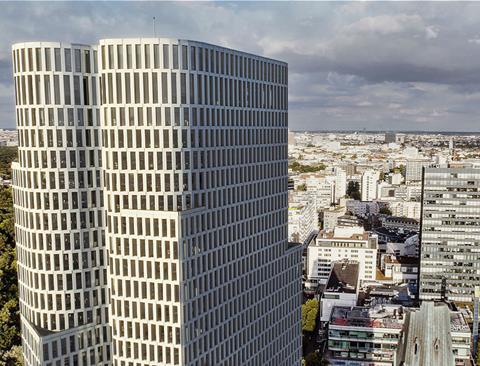Of all European cities, Berlin stands out as the one where the office landscape has changed most significantly in recent years, writes Tony Smedley, head of Schroder European REIT.

Arriving at Berlin’s Tegel-Airport it’s incredible to think that its days are numbered, despite handling 22 million passengers annually. The long-awaited new BER airport on the other side of the old Schoenefeld Airport will soon open while Tegel’s terminals will be transformed into the city’s Urban Tech Republic, a technology and science park for 17,500 people and 5,000 students, although supporters of Tegel airport managed to collect enough signatures to force the government to hold a referendum on Tegel’s future in September. The government is, however, determined to go ahead with the Urban Tech Republic as well as the Schumacher-Quartier, a mixed-use quarter comprising 5,000 new flats, on parts of the airfield.
When the Wall came down 27 years ago, Berlin had almost no modern office space. Tax breaks provided the incentive for investors and developers to flood the market with new supply. Between 1995 and 2003, 500,000 m2 of new office space was delivered annually, but demand lagged significantly behind these volumes.
Today, Berlin is considered one of Europe’s most dynamic cities and its population of 3.5 million is forecast to grow by 8% by 2030. Attracting millions of tourists each year, Berlin has re-emerged as a major European city. As former French culture minister Jack Lang quipped back in 2001, 'Paris is always Paris, but Berlin is never Berlin'.
Mecca for the young and trendy
Economic success is driven by Berlin’s ability to attract young educated people from abroad, making it a mecca for the ‘flat white economy’. Universities ensure a steady supply of the young and trendy, but it’s the abundance of cultural attractions, rich heritage and thriving nightlife that attracts this demographic and has encouraged many international companies to locate there.
An important pillar of Berlin’s success has been its TMT and fintech sector which employs around 85,000 people. Beyond TMT, the city’s economic structure is fairly broad-based including the public sector, legal, finance and consultancy occupiers, as well as some of Germany’s largest private companies: Deutsche Bahn, Deutsche Post, Vivantes, Siemens, Lufthansa, BVG and Deutsche Telekom.
High levels of occupier demand have fed through to Berlin’s office market, reducing Grade A vacancy rates to below 0.5% of stock. Furthermore, much of the limited development pipeline has already been pre-let. providing the right conditions for strong rental growth.
New sub-markets
Competition for space has led to the development of new sub-markets:
The Mediaspree sub-market, to the east of the city centre, is a former industrial area now popular with TMT companies, occupying both modern new-builds and refurbished warehouse space. Despite being 6 km outside the city centre, Mediaspree benefits from an attractive riverside location and charming architecture, with excellent accessibility by tube and S-Bahn. Now, as one of Berlin’s most sought-after residential areas for young professionals, the area is almost at full capacity.
Huge changes are also underway around the new central station, Hauptbahnhof. The city’s most important transport hub boasts a number of new commercial developments, with its proximity to parliament drawing occupiers from federal government. Its urban location has also attracted a number of law and accountancy firms, consultancy businesses and, unsurprisingly, hotels, making vacancies here a rarity.
The City-West area has officially made a come-back. Overlooked by investors and occupiers until relatively recently, there are now a number of projects underway, particularly round the Zoologischer Garten station. One of the most prominent buildings here is the Zoofenster, a tower complex housing the glamorous Waldorf-Astoria hotel as well as high-end office and retail occupiers. The soon-to-launch and adjacent Upper West development (pictured) will add around 44,000 m2 of office, retail and hotel space to this market.
Lastly, the southern end of the famous Friedrichstrasse has drawn investor and occupier attention, most obviously the prominent Rocket-Tower development which serves as headquarters to Rocket Internet. The new Axel Springer HQ here is already underway, pointing to a bright future for this sub-market.
Needless to say, this dramatic influx of office tenants puts pressure on the availability of residential real estate in Berlin, with both rental values and valuations soaring over the past decade.
Berlin’s growth continues and, as overseas developers look to secure holdings in the market, more new locations, particularly those convenient for transport hubs, are emerging. Clearly, it is a European growth city that has a long way to go.










